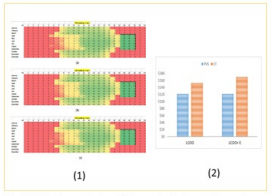Assessments Favor AC-Coupled PVS with BESS Power Plants over Traditional “Dirty Peakers”
Following an assessment of the techno-economics and environmental attributes of comparable power plants, Quantum Energy and Sustainable Solar Technologies (QESST) researchers at Arizona State University (ASU) have concluded that alternating current (AC)-coupled photovoltaics systems (PVS) paired with Battery Energy Storage Systems (BESS) are a considerably better option for power generation than simple cycle gas power plants. The study’s findings show that aggregate lifetime costs are much less for AC-coupled PVS with BESS, even when environmental costs are not included. QESST is a National Science Foundation (NSF) Engineering Research Center (ERC) with additional funding support from the U.S. Department of Energy (DOE).
The results make a compelling argument for adoption and investment in new solar power plant construction. QESST’s assessment examined initial startup costs, lifetime costs of operation, fuel costs, tax credits (ITC), and environmental costs for comparable power plants. The study also explored how well AC-coupled PVS BESS plants perform in meeting peak capacity requirements.
Currently and without tax incentives, the install costs of a 50 megawatt (MW) AC PV plant with 60 MW/240 MWh (megawatt hours) BESS is around $132M compared to $75M for a 70 MW simple cycle gas plant (typically a Combustion Turbine [CT] power plant). However, when assessing the lifetime costs of operation, with fuel costs and tax credits but without environmental costs, the study revealed AC-coupled PVS with BESS cost $122M, compared to $147M for a comparable CT.
Environmental costs further increase the burden of CT power plants. When costs associated with carbon dioxide (CO2), sulfur dioxide (SO2) and nitrogen oxide (NOx) emissions typical of non-baseload power plants are included, additional expenses are incurred for CT plants – calculated to be around $833K annually, along with significant environmental damage and global warming.
The research also revealed that suitably sized AC-coupled PVS can typically meet firm energy capacity requirements of over 95% (usually specified in RFPs) and may even achieve higher levels of capacity factors during the target peak demand period window.
QESST’s findings have been published by MDPI Energies: https://www.mdpi.com/1996-1073/13/2/488



